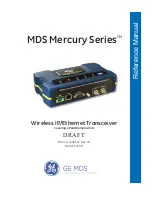
Print Date 08/04/14 Page 6 of 34 S79005-00MA-05
Each Amplifier also has its own front panel ‘mute’ switch, which is mechanically interlocked so that it
has to be operated before the module can be removed. All other signal, 48V dc supply and control
connectors are at the rear of the unit. The control connectors go to one of two independent internal
Transmitter control buses.
Each control bus has its own RS485 data bus which is used to carry the monitored serial information
from the amplifier to the E2023 Controller. Each bus also has its own power level control line, derived
from the E2026 Drive Changeover/Output Monitor Unit, to set the power level of each amplifier module
and thus the final Transmitter output power.
Various versions of the 300W Amplifier Module may be supplied (E2021-XX where XX indicates
version). These versions have slightly different internal circuitry. They are interchangeable but, since
this Transmitter only has two fitted, to maximise output power, both modules should be the same
version (or all four in a combined pair of Transmitters).
1.1.2 : E2088 or E2322 Power Supply Unit
All variants except -01 and -03 (Psu1) have two Power Supply Units fitted (Psu1 and Psu2). E2088
PSU’s are fitted on -01, –02, -05 and -07 variants. E2322 PSU’s are fitted on -03, –04, -06 and –08
variants. Note that the two types are not interchangeable. The –01 to –04 variants have a single mains
supply input. The –05 to –08 variants have dual mains supply inputs to give greater redundancy.
Psu1 and Psu2 are OR’d to provide supply buses to the E2021 Amplifier Modules on the right and left
hand sides of the Transmitter. Single units requiring power (E2023 and E2026) and both cooling fans
are also supplied from both left and right hand buses. All supplies are switched via a single front panel
safety switch.
Each Power Supply Module has its own forced air cooling, output control and monitoring circuitry and
generates a fixed regulated 48Vdc supply. On the -02 and the -04 to –08 variants, failure of a single
Power Supply Module leaves the transmitter still operating at full output power. In this case, as with
the Amplifier Modules, the faulty Power Supply module can be removed or replaced, within seconds,
whilst the Transmitter is operating at full power. Red/green fault displays, relatively low weight and
small size again feature.
48Vdc outputs for each Amplifier and for all the low power single units are provided via fuses at the
rear of the Transmitter. The Power Supply monitor connectors go to one of two independent internal
Transmitter control buses and hence to the E2023 Controller.
Mains supplies outputs for one or two Exciters are provided via fuses at the rear of the Transmitter. In
the –01 to –04 variants, two outputs are provided, both derived from the single mains supply to the
Transmitter. In the –05 and –06 variants, two independent supplies are provided, each being derived
separately from one or other of the dual supplies to the Transmitter. On the –07 and –08 variants, a
fused 48V dc output is provided at the rear, for ancillary equipment, in place of one of the mains
supply outputs.
1.1.3 : E2023 Transmitter Controller Unit
This single unit provides comprehensive monitoring of the forward power, current and temperature of
each E2021 Amplifier Module and of the final output forward power, reverse power and temperature
via the E2026 Drive Changeover/Output Monitor. It also monitors the E2088/E2322 Power Supply
Modules. In the situation where dual drive automatic changeover or automatic power level control is
used, this unit provides the necessary control. Remote control and monitoring of the Transmitter can
also be provided via this unit using parallel or serial data.
The Control Unit is microprocessor based with a back illuminated, high contrast 4 line by 20 character
display and separate red/green ‘System Normal’ indicator. A robust, sealed membrane keypad is
provided with a sounder to indicate correct key entry. The rear of the unit has separate connectors for
the two independent internal Transmitter control buses, connectors to monitor and control one or two
Exciters, a connector for power level control and a connector for parallel monitoring. An RS232
monitor/control port is provided on the front panel (E2023-01/02) or rear panel (E2023-03/04) with an
additional TCP/IP monitor/control port on the rear (E2023-02/04 only). In the latter cases, selection of
RS232 or TCP/IP is done by internal links.







































